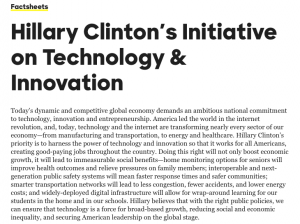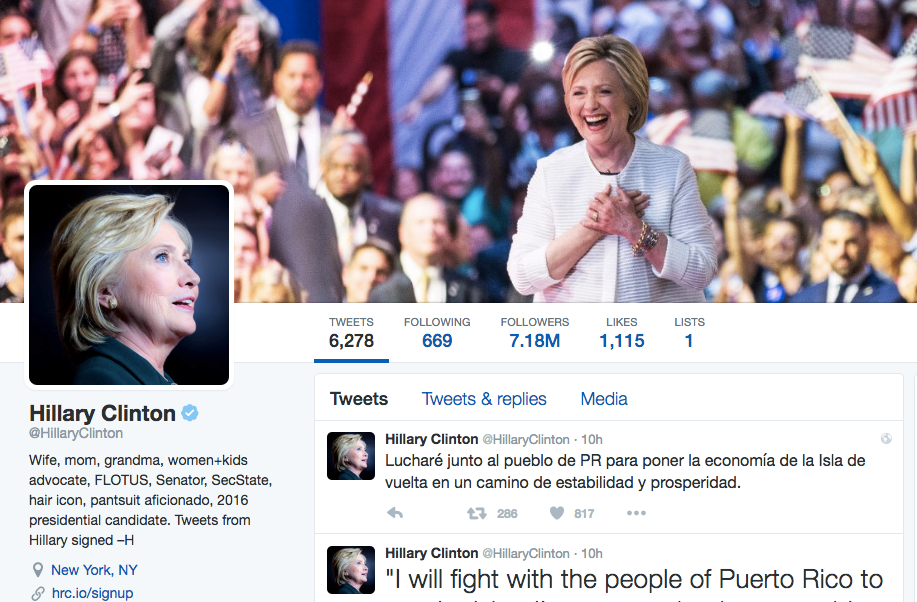As you probably know, there is an election coming up — five long months ahead.
And as we all know and understand, elections matter. My fear has been that the coming months will be more about screaming about how the other person is going to destroy the country rather than what the candidate would do to move us forward. And there are big challenges ahead, particularly for government.
We have tried to focus on my favorite six words: Help government do its job better. And to that end, we’ve been talking to people about what the candidates can — and should — do come January 20, 2017. (And one not from us but it is one of my favorites: Meritalk’s suggestion that we keep Tony Scott as the federal CIO – regardless of who wins.)
 As we try to focus on issues rather than the screaming… The Hillary Clinton campaign has just posted its “Initiative on Technology and Innovation.”
As we try to focus on issues rather than the screaming… The Hillary Clinton campaign has just posted its “Initiative on Technology and Innovation.”
Two-thirds of it focuses on the private sector, understandably. But there is a whole section there about a “smarter and more innovative government,” which I have included below.
Two brief asides and a note… first a H/T: Jennifer Pahlka, executive director and founder of Code for America, has posted her thoughts on the plan: “Digital in the Next Administration: The Path Forward”.)
Secondly, NOTE: The Trump campaign does not have similar kind of position paper that I was able to find — I spent some time on the Web site but was not able to find anything either under the issues or positions section of the Trump Web site. If the campaign does have something, I am happy to post it.
Finally, this only the section on government. Follow the link to the full Clinton “Initiative on Technology and Innovation.”
SMARTER AND MORE INNOVATIVE GOVERNMENT
Hillary believes that, beyond enabling innovation and economic growth, we should look to technology and data to provide better services to the American people, and make government smarter and more effective. Specifically, Hillary will:
- Make Government Simpler and More User Friendly: The federal government too often operates with websites designed from another era. They are too complicated, too hard to use, and rarely designed for mobile phones or tablets. After the rocky release of Healthcare.gov, the Obama Administration launched the U.S. Digital Service, with a small group of technologists in the White House and the vision of deploying small technology teams throughout federal agencies. The U.S. Digital Service is already delivering results—making it easier for students and their families to compare college options, and easier for applicants to file immigration forms. But USDS and similar programs are only in their infancy. Hillary will:
- Make Digital Services a Permanent Priority for Federal Agencies: Hillary will make the USDS and other digital services a permanent part of the executive branch to ensure that technical innovation becomes an ongoing feature of American governance. There should be a constant flow of technology and design experts working to make it easier for Americans to get affordable health insurance, apply for student loans, or get the veterans benefits they deserve. Hillary will expand dedicated Digital Service teams throughout federal agencies (including civil servants and outside experts), and ensure that CIOs are part of this innovation agenda. She will maintain support for other federal tech programs—18F, Innovation Fellows, and Innovation Labs—and look to them to develop a coordinated approach to tackling pressing technology problems. She will also explore ways to leverage these capabilities to help our state and local governments with their own tech issues and agencies.
- Transform the Top 25 citizen-facing Government Services: Hillary will charge the USDS with transforming and digitizing the top 25 federal government services that directly serve citizens. For each one, the USDS would redesign them to meet the needs of citizens in the 21st century; publish detailed performance and customer service metrics, including creating a “Yelp for government” that allows for easy citizen rating; and embrace the industry best practice of continuous site improvement. Hillary will make sure that government delivers on results for citizens.
- Eliminate Internal Barriers to Government Modernization: The federal government uses cumbersome processes for buying information technology and hiring technical experts. And it has outdated laws and rules which impose internal impediments to building modern digital services—i.e., it can take many months to make simple changes to a website or get a digital form approved. Hillary will streamline procurement processes and get rid of unnecessary internal red tape that prevents government from developing intuitive and personalized digital experience that they have come to expect from great consumer internet companies.
- Use the Best and Most Cost Effective Technology: The federal government spends nearly $90 billion in information technology but the American taxpayer doesn’t get $90 billion in value. Hillary will make it easier for the federal government to find, try, and buy innovative technology—including open source software. She would also break large federal IT projects into smaller pieces, so it will be easier to stop projects that are over budget or failing to meet user needs, and also more feasible for small and medium-sized businesses to support public service projects.
- Open up More Government Data for Public Uses: The Obama Administration broke new ground in making open and machine-readable the default for new government information, launching Data.gov and charging each agency with maintaining data as a valuable asset. With more accessible datasets, entrepreneurs can create new products and services, citizens can evaluate more effectively how the government does it job, researchers can look for new insights – and government can work better. Hillary will continue and accelerate the Administration’s open data initiatives, including in areas such as health care, education, and criminal justice. She would fully implement the DATA Act to make government spending more transparent and accountable to the American people, improving USASpending.gov so that Americans can more accurately see how and where their taxpayer dollars are spent. She would also bring an open data approach to regulation—making it easier for businesses to submit structured data instead of documents, and bringing greater transparency to financial and other markets so that regulators, watchdog groups, and the American people can more easily identify fraud and illegal behavior.
- Harden Federal Networks to Improve Cybersecurity: U.S. government networks have long been subject to intrusions from hackers with various affiliations and objectives. Hillary is committed to increasing the security of our government networks, making it harder for hackers to gain unauthorized access. She will prioritize the enforcement of well-known cybersecurity standards, such as multi-factor authentication, as well as the mitigation of risks from known vulnerabilities. She will encourage government agencies to consider innovative tools like bug bounty programs, modeled on the Defense Department’s recent “Hack the Pentagon” initiative, to encourage hackers to responsibly disclose vulnerabilities they discover to the government. And she will bolster the government’s ability to test its own defenses by increasing the capacity of elite, cleared government red teams to help agencies find and fix vulnerabilities before hackers exploit them.
- Facilitate Citizen Engagement in Government Innovation: The Obama Administration has encouraged agencies to use new approaches to improve their functions and better serve the American people. In turn, agencies are now using “incentive prizes” to uncover creative solutions from citizen solvers, Idea Labs to empower front-line employees, and flexible procurement authorities to engage startups. Hillary will champion these strategies, putting innovation at the heart of her management agenda. She will direct the members of her Cabinet to increase the number of federal employees that identify and implement new ideas from citizens and businesses to help government serve the country more effectively.
-
Use Technology to Improve Outcomes and Drive Government Accountability:Advances in data analytics, presentation, and communications have driven a transformation in how modern businesses track their performance, both internally and externally. Data-driven dashboards that present an organization’s goals and their performance against those goals are increasingly the norm, as is the open communication of this performance data to the entire organization. The Obama Administration embraced this management approach by creating performance.gov, which presents goals and progress for major government agencies. Hillary will also embrace this practice of prioritized goal setting and performance tracking for the federal government. Her agenda and priorities would be clearly articulated on performance.gov; progress against these goals would be demonstrated, using up-to-date, real time data; and issues blocking progress would be presented, along with action plans to address them. By promoting this high type of transparency and accountability, and leveraging technology to do so in a real-time manner, citizens will develop greater confidence that their government is working for their common good.





Leave a Reply
You must be logged in to post a comment.